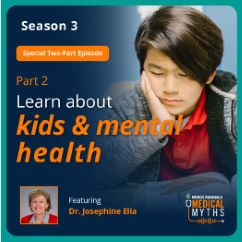Although it is sometimes assumed that childhood and adolescence are times of carefree bliss, as many as 20% of children and 1 in every 4 to 5 adolescents in the United States have a diagnosable psychiatric disorder that causes distress and functional impairment (1, 2). With increasing age, the prevalence of psychiatric disorders increases. Furthermore, 27.9% of US adolescents aged 13 to 17 are reported to meet criteria for 2 or more disorders (3). Studies that follow children from birth to adulthood indicate that most adult mental health disorders begin in early childhood and adolescence (4). Genes associated with psychiatric disorders have been reported to show high expression throughout the lifespan, beginning in the fetus in the second trimester and impacting neurodevelopmental processes, which may explain the early ages of onset (5). Most of these disorders may be viewed as exaggerations or distortions of typical behaviors and emotions.
Like adults, children and adolescents vary in temperament. Some are shy and reticent; others are socially exuberant. Some are methodical and cautious; others are impulsive and careless. Whether a child is behaving like a typical child or has a psychiatric disorder is determined by the presence of impairment and the degree of distress related to the symptoms. For example, a 12-year-old girl may be frightened by the prospect of delivering a book report in front of her class. This fear would be viewed as social anxiety disorder only if her fears were severe enough to cause significant distress and avoidance.
There is much overlap between the symptoms of many disorders and the challenging behaviors and emotions of children without a psychiatric disorder. Thus, many strategies useful for managing behavioral problems in children can also be used in children who have psychiatric disorders. Furthermore, appropriate management of childhood behavioral issues may decrease the risk of temperamentally vulnerable children developing a clinical disorder. Also, effective treatment of some disorders (eg, anxiety) during childhood may decrease the risk of a mood disorder later in life.
The most common psychiatric disorders of childhood and adolescence fall into the following categories:
Disruptive behavioral disorders (eg, attention-deficit/hyperactivity disorder [ADHD], conduct disorder, and oppositional defiant disorder)
Neurodevelopmental disorders
Schizophrenia and related psychotic disorders are much less common. Pediatric catatonia is more common than childhood schizophrenia. It may present as a psychiatric disorder but often occurs in medical conditions (eg, infections, metabolic disorders) and may frequently be undetected by pediatricians (6).
However, more often than not, children and adolescents have symptoms and problems that cut across diagnostic boundaries. For example, 15 to 35% of children with ADHD also have an anxiety disorder, and 12 to 50% meet the criteria for a mood disorder (eg, depression) (7).
Neurodevelopmental disorders affect both mental health and overall development in children. Some of these disorders include
General references
1. Merikangas KR, He JP, Burstein M, et al. Lifetime prevalence of mental disorders in US adolescents: Results from the National Comorbidity Study – Adolescent Supplement (NCS-A). J Am Acad Child Adolesc Psychiatry 49(10):980-989, 2010.
2. Elia J, Pajer K, Prasad R, et al. Electronic health records identify timely trends in childhood mental health conditions. Child Adolesc Psychiatry Ment Health. 2023;17(1):107. Published 2023 Sep 14. doi:10.1186/s13034-023-00650-7
3. Kessler RC, Avenevoli S, McLaughlin KA, et al. Lifetime comorbidity of DSM-IV disorders in the National Comorbidity Survey – Replication Adolescent Supplement (NCS-A). Psychol Med. 42(9)1997-2010, 2012.
4. Solmi M, Radua J, Olivola M, et al. Age at onset of mental disorders worldwide: large-scale meta-analysis of 192 epidemiological studies. Mol Psychiatry. 2022;27(1):281-295. doi:10.1038/s41380-021-01161-7
5. Lee PH, Anttila V, Won H, et al. Genome-wide meta-analysis identifies genomic relationships, novel loci, and pleiotropic mechanisms across eight psychiatric disorders. Cell. 2019. doi.org/10.1101/528117
6. Dhossche DM, Wachtel LE. Catatonia is hidden in plain sight among different pediatric disorders: A review article. Pediatr Neurol. 43(5):307-315, 2010. doi: 10.1016/j.pediatrneurol.2010.07.001
7. Gnanavel S, Sharma P, Kaushal P, Hussain S. Attention deficit hyperactivity disorder and comorbidity: A review of literature. World J Clin Cases. 2019;7(17):2420-2426. doi:10.12998/wjcc.v7.i17.2420
Evaluation of Psychiatric Disorders
Evaluation of psychiatric symptoms in children and adolescents differs from that in adults in important ways:
The developmental context (how the child has been developing over time and compared to peers) is critically important in children. Behaviors that are expected at a young age may indicate a psychiatric disorder if present at an older age.
Children exist in the context of a family system, and that system has a profound effect on their symptoms and behaviors; children without a psychiatric disorder who are living in a family with violence or substance use disorders may superficially appear to have one or more psychiatric disorders.
Children also exist in the context of environmental stressors (eg, COVID-19 pandemic, military conflict). The resultant disruption of critical routines and isolation from extended family, peers, teachers, and cultural and religious groups have a significant impact, especially on the most vulnerable groups (1).
Children often do not have the cognitive and linguistic sophistication needed to accurately describe their symptoms. Thus, the clinician must rely very heavily on direct observation corroborated by observations of other people, such as parents, teachers, or other caregivers.
In many cases, developmental and behavioral problems (eg, poor academic progress, delays in language acquisition, deficits in social skills) are difficult to distinguish from those due to a psychiatric disorder. In such cases, formal developmental and neurological testing should be part of the evaluation process.
Because of these factors, evaluation of children with a psychiatric disorder is typically more complex than that of adults and may require a multi-disciplinary approach including developmental pediatrics, psychology, psychiatry, and genetics. Coordination of care with the primary care provider (eg, pediatrician or family practitioner) is essential.
Evaluation reference
1. Walter HJ, Bukstein OG, Abright AR, et al. Clinical practice guideline for the assessment and treatment of children and adolescents with anxiety disorders. J Am Acad Child Adolesc Psychiatry 59(10):1107-1124, 2020. doi: https://doi.org/10.1016/j.jaac.2020.05.005


